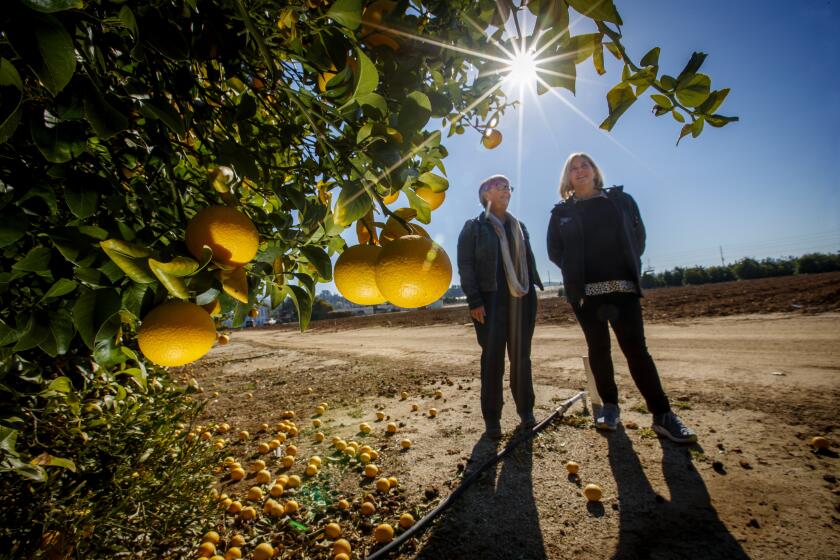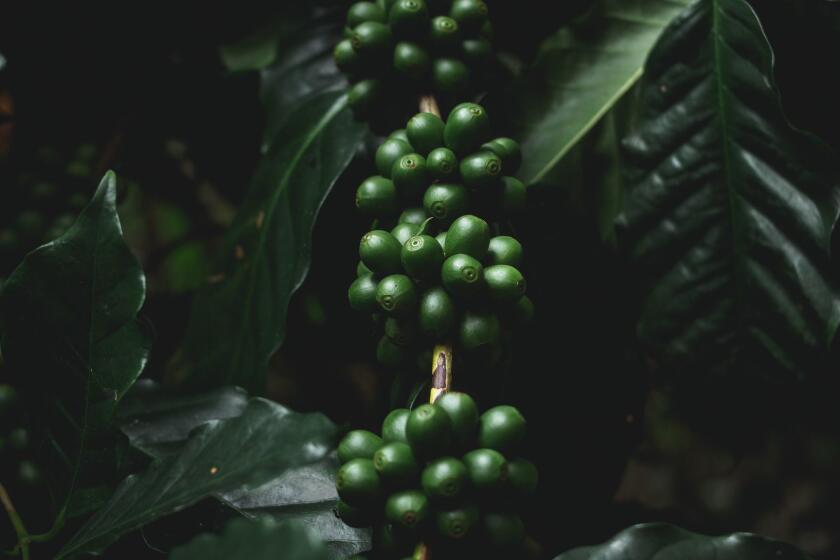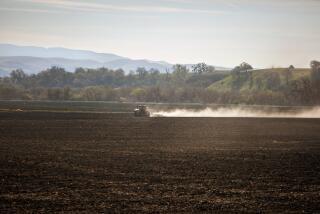California farmers and scientists race to combat a citrus disease infecting trees
The world’s most insidious citrus disease invaded Florida in 2005, wreaking havoc on its iconic groves with stunning speed. After just a decade, virtually every citrus tree in the state was dying or infected.
Then in 2012, the disease — Huanglongbing, commonly known as citrus greening — was discovered in California. It showed up first in a Hacienda Heights backyard, on a pummelo branch derived from budwood that had been smuggled from China, where the disease is epidemic.
The next infected tree wasn’t found until 2015, and for two years after that only 81 more turned up. In mid-2017, however, a new sampling method and improved detection technology led to the discovery of far more HLB-positive trees in California: 1,135 as of March 11.
Now researchers and farmers are racing to fend off the disease. This month, more than 500 scientists from around the world gathered in Riverside at the sixth International Research Conference on Huanglongbing, meeting in California for the first time. Their findings show that although the disease is spreading rapidly in the Southland and no breakthrough is imminent, a host of new detection methods and strategies could help California avert the kind of disaster that destroyed almost three quarters of Florida’s citrus production.
Huanglongbing originated in Asia a century or more ago. It is caused by a bacterium, Candidatus Liberibacter asiaticus, transmitted by a tiny insect, the Asian citrus psyllid, which feeds on young citrus leaves. HLB clogs citrus trees’ phloem, a vascular tissue that transports sugar from the leaves; this causes the most symptomatic fruit to become small and bitter, and eventually makes trees unproductive or kills them.
Until now California has avoided painful losses from HLB, but that may be changing.
“I would describe the current trend as exponential,” said Neil McRoberts, an associate professor of plant pathology at UC Davis.
It has been described as a Noah’s Ark for citrus: two of every kind.
The infected trees have been found mainly in Orange County, where Garden Grove and Santa Ana accounted for 702 detections, and in the San Gabriel Valley and adjacent regions of Los Angeles County. So far confirmed detections have all been in backyard trees, not commercial groves.
Agricultural authorities promptly cut down all the infected trees, but these may be only the tip of the iceberg because the standard HLB test can take many months or years to detect a new infection. During this time trees appear normal but can infect feeding psyllids, which in turn can spread the disease to other trees.
Scientists have labored for a decade to develop devices to detect the disease earlier, but recently a low-tech solution has proved more promising: dogs trained to sniff HLB-infected trees.
You could soon be seeing lemons at your favorite taco stand instead of limes.
Trained dogs can actually smell the bacteria within a few weeks after infection, Tim Gottwald, a U.S. Department of Agriculture plant pathologist, said during a presentation at the Riverside conference. In Florida they’ve been 99% accurate, and in tests in December and February under challenging conditions (such as distractions from homeowners’ dogs) in Southern California backyards, they were right more than 92% of the time, he added.
If the canines are right, HLB may be more widespread than standard tests show. Two years ago, the dogs signaled infections in 72 trees at UC Riverside and in four trees in two commercial groves in Kern County. The trees continue to appear negative on molecular tests, but this method typically lags infection. Some California scientists maintain, and hope, that the dogs are wrong, perhaps because they’re smelling something else in the trees, but only time will tell.
Detecting and removing infected trees is half the battle; controlling the insect vector is equally crucial. After the Asian citrus psyllid showed up in California in 2008, citrus growers started spraying to suppress it, and growers in psyllid quarantine areas are now required to do so to sell their fruit to packinghouses.
In urban areas, where systematic spraying is problematic, University of California scientists began in 2011 to release a natural enemy of the psyllid from Pakistan, a parasitic wasp named Tamarixia radiata, which has significantly reduced but not eliminated psyllid populations.
The Asian citrus psyllid continues to spread each year, and is now present in 28 California counties. It’s most abundant in the coastal and Inland Empire districts of Southern California, where citrus trees develop new leaves frequently, providing plentiful food for psyllids. In the San Joaquin Valley, the state’s leading citrus-growing area, and in the hot desert valleys, conditions are less favorable for psyllids, and growers have been able to suppress populations below detectable levels most of the year.
Coffee culture in Los Angeles, at least in the last decade or so, has taken hold in fancy food halls and shops that look more like steampunk boutiques than old-school coffee-pot-and-pancake diners.
The stakes are high. Scientists, growers and state and federal agricultural authorities have learned from the worst-case scenario in Florida, where HLB was detected in 2005. Florida orange production dropped from 240 million 90-pound boxes in 2003-2004 to 45 million in 2017-18, when Hurricane Irma blew much of the crop off the trees. Backyard citrus virtually disappeared. Farming costs tripled, many groves and packinghouses went out of business, and the end of Florida’s citrus industry appeared near.
This season, however, the orange harvest bounced back to an estimated 77 million boxes, up from 69 million two years ago. Scientists say that farmers are using careful applications of micronutrients and fertilizer to at least partially restore root function, tree health and productivity.
The top citrus-growing countries of the world other than the United States, including Brazil, China and Mexico, have all managed to increase citrus production in the last decade, despite major losses from HLB. However, many successful growers in these countries rely on intensive spraying to suppress psyllids, which aside from any environmental harm may be unsustainable because the psyllid is likely to develop resistance unless care is taken to rotate use of multiple insecticides.
One of the more controversial therapies for HLB involves spraying or injecting citrus trees with oxytetracycline or streptomycin, bactericides that have long been used in human and veterinary medicine, and to treat apple and pear trees. Citrus growers in Florida have applied them for three years to slow the disease’s progression and to protect young trees from infection. Growers in California within 15 miles of HLB-infected trees are allowed to use them, but have not done so yet.
Public-health advocates fear that such use may contribute to the development of antibiotic-resistant diseases in humans; scientists who have performed studies on use of the sprays in citrus say there is no potential for resistance.
Most scientists believe that genetically modified citrus is the most promising long-term solution for strong HLB resistance and perhaps immunity, despite suspicion from activists and some consumers. Southern Gardens Citrus, which grows 14,000 acres of citrus in Florida, has field trials of transgenics created through insertion of foreign genes, though the company says it is likely to be eight to 12 years before production orchards are planted.
Southern Gardens is also testing trees made resistant to HLB by a newer method that produces antimicrobial proteins derived from spinach. If it receives the necessary approvals from the USDA, the Environmental Protection Administration and state regulators, the company hopes to plant commercial groves of orange trees using this technology as soon as late 2020. The fruit from these trees will not have to be labeled as genetically modified.
In potentially the most important discovery announced at the conference, Wayne Hunter, a research entomologist with the USDA in Fort Pierce, Fla., has used a new technique that successfully edited the Asian citrus psyllid’s genes to reduce its lifespan and fertility.
“If they’re really able to transform citrus psyllids and it can be done routinely, this is a big deal,” said Fred Gmitter, a professor at the University of Florida Citrus Research and Education Center.
One currently available and noncontroversial way to protect groves is to plant under protected screenhouses, which exclude psyllids and therefore HLB. Test plantings have produced large crops of attractive, premium-quality fruit in Florida, and Florida growers have recently planted 320 acres, but such a system probably wouldn’t make sense in California until HLB ravages commercial groves.
More than 20 million households around the world make their living producing coffee.
As backyard and commercial growers consider what comes next, the danger from HLB is likely to be most severe in coastal and Inland Empire districts, where the moderate climate favors psyllids and infected urban trees are nearby. In the San Joaquin Valley, freezing winter temperatures help kill psyllids, giving growers hope that HLB will be relatively manageable. This advantage may not last, however.
“We’re very close to a cusp in the Central Valley, and if we had a one- to two-degree increase in winter temperatures, that would completely change the scenario,” said Gottwald, the USDA plant pathologist.
For both backyard and commercial growers, it’s hard to know what the future will bring because so many factors — proximity to infected trees, psyllid populations, climate, fruit type, horticultural practices, farm size and the availability of effective therapies — will affect citrus plantings’ vulnerability to HLB infection and decline.
It’s likely, however, that many more backyard trees in Southern California will succumb to this intractable disease, and that after dodging a bullet for seven years, commercial growers will soon be in a pitched battle to keep the region’s citrus culture thriving.
What fruit is most at risk?
No citrus grown commercially is immune to HLB, but there’s considerable variation in susceptibility.
Grapefruits are the most susceptible, followed by oranges and small-fruited (Key-type) limes. Bearss limes (the main commercial type) and lemons are fairly tolerant; they get infected and develop some HLB symptoms but continue to crop relatively normally.
Mandarins, which are more genetically diverse, range from very vulnerable to quite tolerant. For example, trees of SugarBelle, a rich-flavored cross of clementine and Minneola tangelo bred at the University of Florida, have remained reasonably healthy and productive. This and other reportedly tolerant Florida varieties are now undergoing therapy and testing in Riverside, and if commercialization agreements are reached, some may become available to California nurseries and growers.
More to Read
Eat your way across L.A.
Get our weekly Tasting Notes newsletter for reviews, news and more.
You may occasionally receive promotional content from the Los Angeles Times.












